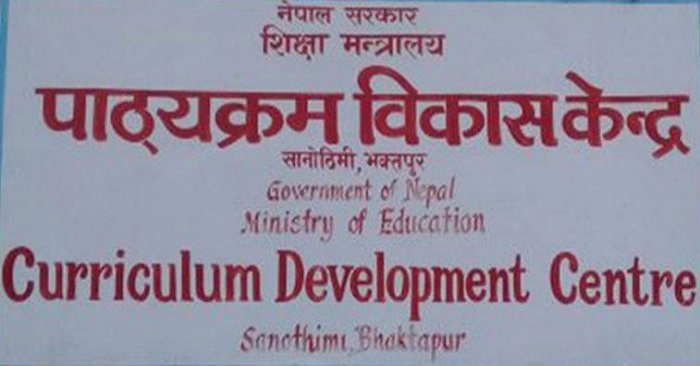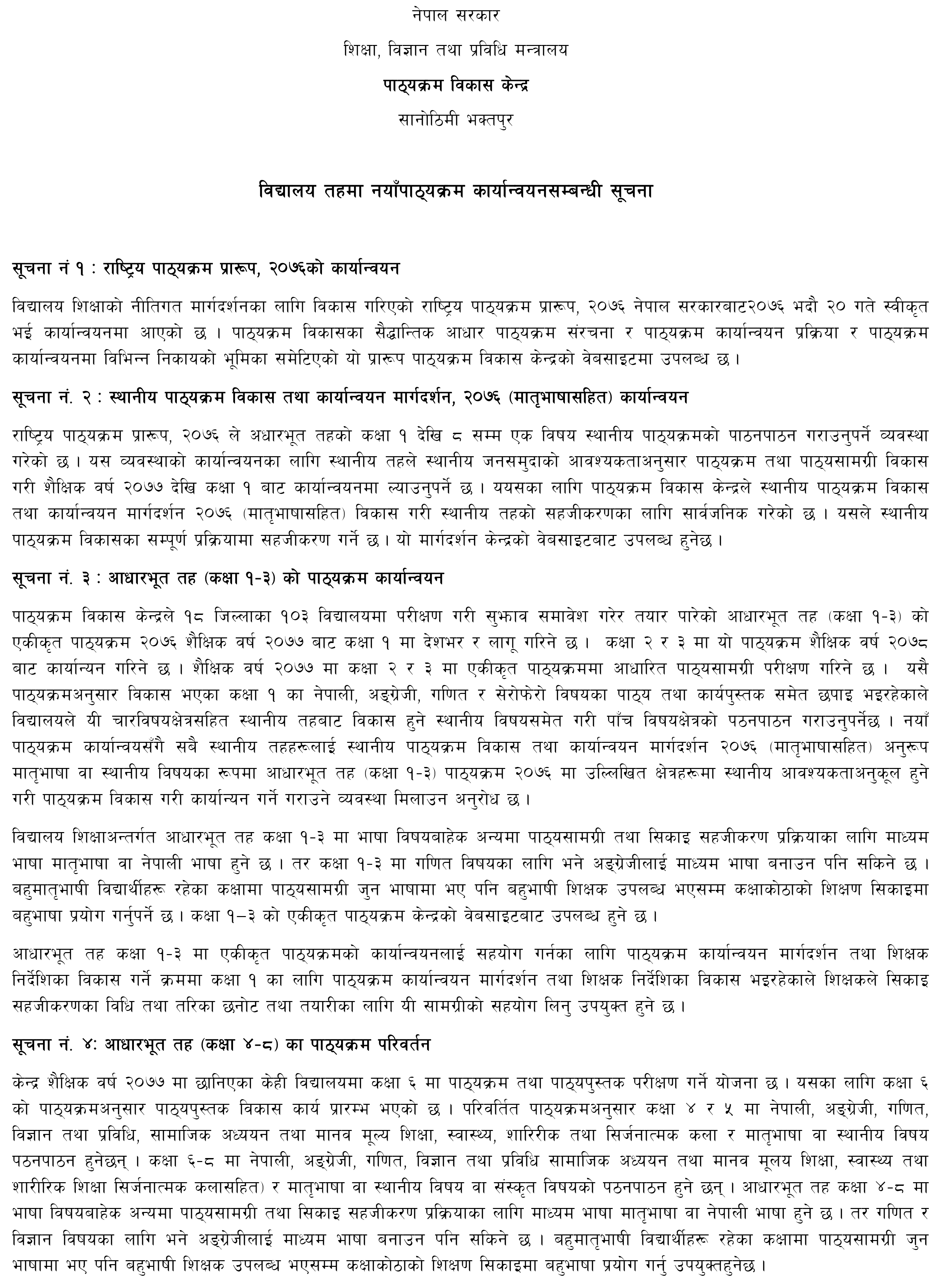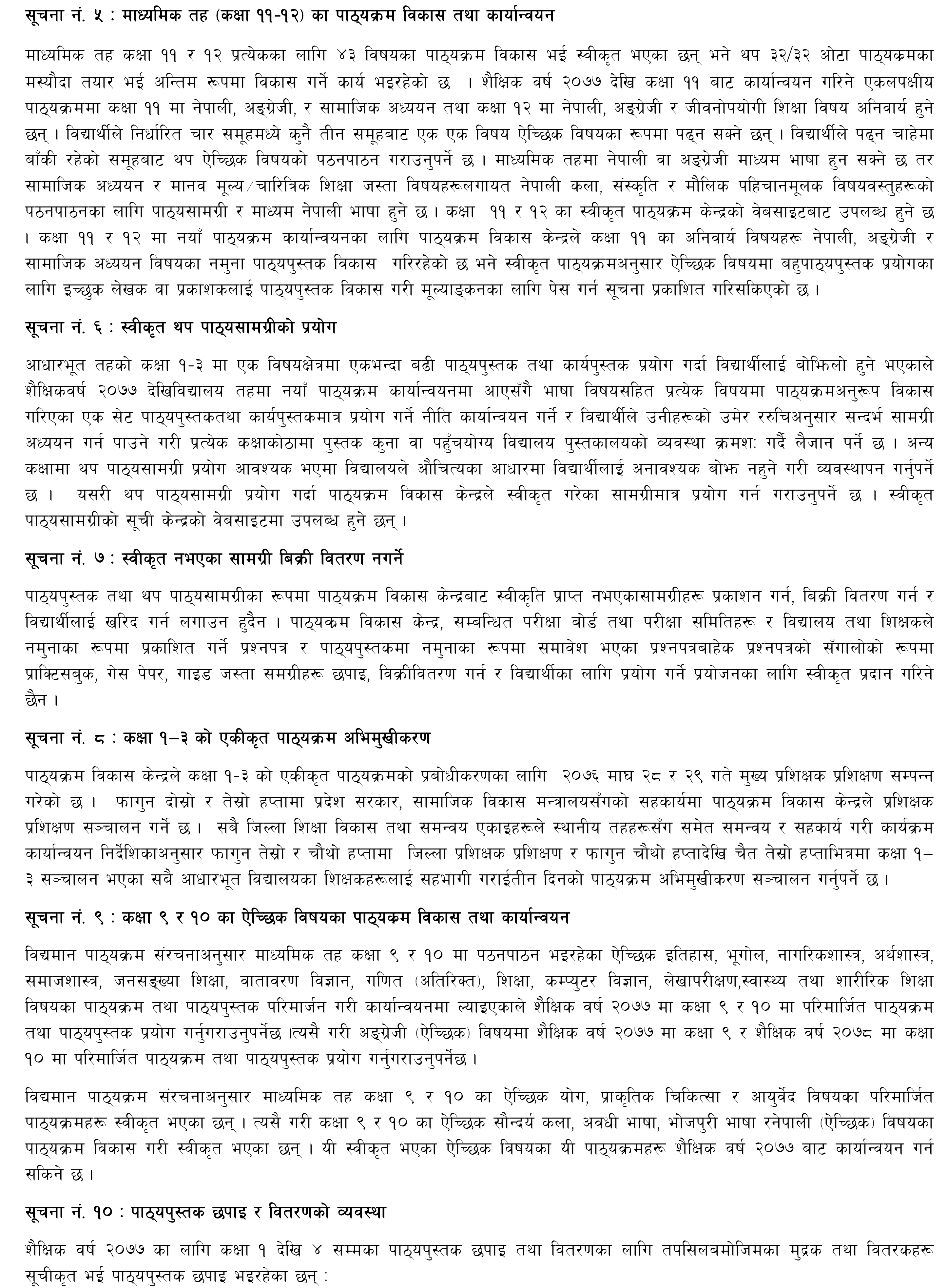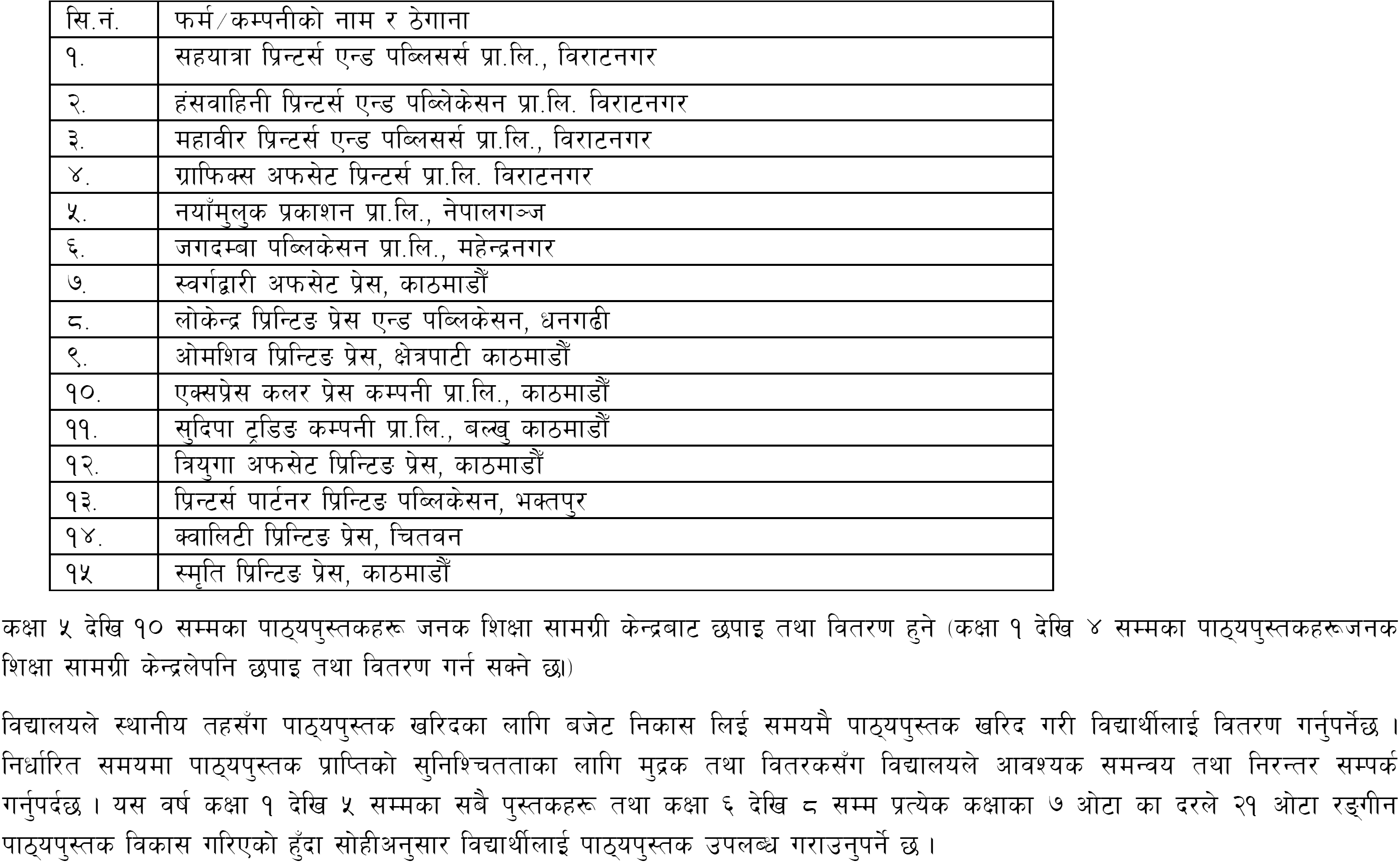



Notice of Implementation of the New Syllabus at the School Level:
Curriculum Development Center, Sanothimi, Bhaktapur
Notice regarding the implementation of the new syllabus at the school level
Notice No. 1: Implementation of the National Curriculum Format, 2076 The National Curriculum Framework, developed for the policy guidance of school education, has been approved and adopted by the Government of Nepal on 2076/05/20. The theoretical basis of curriculum development, which covers the structure of the curriculum and the role of various bodies in the curriculum implementation process and curriculum implementation, is available on the website of the Course Development Center.
Notice No. 2:
Local Curriculum Development and Implementation Guide, 2076 (including mother tongue) Implementation National Curriculum Format, 2076 has made provision of teaching local curriculum for a subject from class 1 to 8 at the basic level. For the implementation of this arrangement, the local level should develop curriculum and curriculum as per the needs of the local people and implement it from Class 1 to the academic year 2077. For this, the Curriculum Development Center has made it public for local level facilitation by developing Local Curriculum Development and Implementation Guidelines 2076 (including mother tongue). This will facilitate the whole process of local curriculum development. This guide will be available from the center's website.
Notice No. 3:
Implementation of the Basic Level (Classes 1-3) Curriculum Implementation The curriculum development center will be implemented in 103 schools in 18 districts and include suggestions. This course will be implemented in Classes 2 and 3 from the academic year 2078. The curriculum based on an integrated curriculum will be tested in Classes 2 and 3 in the academic year 2077.
Since the curriculum and workbook of Nepali, English, Mathematics, and Serofero subjects are being printed in this course, the school will have to study all five areas including these four subject areas as well as the local development. With the implementation of the new syllabus, all local levels are requested to make arrangements for developing and implementing the curriculum in accordance with local curriculum development and implementation guidelines 2076 (including mother tongue) or local level as local subject (Class 1-3) in areas specified in curriculum 2076.
The basic language under school education will be the mother tongue or Nepali language for the curriculum and learning facilitation process other than the language subject in classes 1-3. But for mathematics subjects in grades 1-3, English can also be made a medium language. Multilingual students have to use multilingual in classroom teaching as long as multilingual teachers are available. Classes 1-3 will be available from the integrated curriculum center website.
As the curriculum implementation guidelines and teacher guides are being developed to support the implementation of an integrated curriculum in basic level classes 1-3, it will be appropriate for the teacher to use these materials for selection and preparation of teaching facilitation methods and methods as the curriculum implementation guidelines for class 1 are being developed.
Notice No. 4:
The curriculum change center at the basic level (classes 4-8) plans to test the curriculum and textbook in class 6 in some schools selected in the academic year 2077. For this, the textbook development work has been started according to the syllabus of class 6. According to the changed syllabus, classes 4 and 5 will include Nepali, English, mathematics, science and technology, social studies and human value education, health, physical and creative arts, and mother tongue or local subjects. Classes 6-8 include Nepali, English, mathematics, science and technology, social studies and human-origin education, health and physical education, including creative arts) and mother tongue or local subject or Sanskrit subject. Except for the language level in the basic level classes 4-8, the medium language for the curriculum and learning facilitation process will be a mother tongue or Nepali language. But for mathematics and science subjects, English can also be made a medium language. In the classroom where there are multilingual students, it will be appropriate to use multilingual teaching in the classroom teaching as long as the multilingual teacher is available.
Notice No. 5:
Curriculum Development and Implementation of Secondary Level (Class 11-12) The syllabus of 43 subjects have been developed and approved for secondary level Class 11 and 12 each, while additional 32/32 syllabus drafts are being prepared and finalized. The one-sided curriculum, implemented from Class 11 to the academic year 2077, requires the subjects of Nepali, English, and social studies in Class 11 and Nepali, English and life-long education in Class 12. Students will be able to read each topic as an optional subject from any of the three groups. If the student wishes to read, additional elective subjects should be taught from the rest of the group. There may be Nepali or English medium language at the secondary level, but the curriculum and medium for the reading of Nepali arts, culture and fundamental identity subjects, including social studies and human values ââ/ character education, will be the Nepali language.
The approved courses for Classes 11 and 12 will be available from the Center's website. The curriculum development center is developing a sample textbook on Nepali, English and social studies subjects for the implementation of the new syllabus in Class 11 and 12 while publishing information for submission of evaluation textbook to the aspiring author or publisher for elective curriculum use in elective subjects as per the approved curriculum.
Notice No. 6:
The use of approved additional curriculum will make it more cumbersome for students to use more than one textbook and workbook in one subject area in basic level classes 1-3. The student is allowed to study their age rarucianusara reference book every corner of the classroom or school library is accessible, respectively, are required to take. If the use of additional curriculum in other classes is required, the school will have to manage the students on an appropriate basis so as not to be unnecessarily burdensome. When using the additional curriculum, only the materials approved by the curriculum development center should be used. A list of approved courses will be available on the Center's website.
Notice No. 7:
Unapproved materials are not required to publish materials, distribute sales, and purchase students who have not been approved by the Curriculum Development Center as textbooks and additional curricula that do not distribute sales. In addition to the question papers contained in the curriculum development center, the respective examination boards and examinations committees and schools and teachers, the contents of the question paper, as well as the question papers included in the textbook, will be approved for printing, distribution and use for student purposes. Will not be done.
Notice no. 8:
Integrated Curriculum Orientation for Classes 1-3 The Curriculum Development Center has completed the training of Head Instructor on 2076/10/28 and 29 for the implementation of the Integrated Curriculum for Classes 1-3. The curriculum development center will be conducting trainer training in collaboration with the state government and the Ministry of Social Development in the second and third weeks of February. All District Education Development and Coordination Units should coordinate and cooperate with local levels as per the program implementation guidelines, district teacher training in the third and fourth week of February and all three elementary school teachers in Chaitra third week starting from the fourth week of February should participate in three-day course orientation.
Notice No. 9:
Curriculum development and implementation of elective subjects in grades 9 and 10 According to the existing curriculum structure, there are elective history, geography, civics, economics, sociology, population education, environmental science, mathematics (extra), education, computer. Modifying and implementing curriculum and textbooks for science, audit, health and physical education Ñ ââlyaiekale academic year in 2077 in Class 9 and 10 shall be made using the modified curriculum and textbook. Similarly English (optional) concerning the academic year 2077 in Class 9 and Class 10 in the modified course in the academic year 2078 and shall be made use of textbooks. According to the existing curriculum structure, modified courses for secondary yoga classes 10 and elective, natural medicine and Ayurveda have been approved. Similarly, the curriculum for elective beauty arts, period language, Bhojpuri language and Nepali (elective) subjects of Classes 9 and 10 have been approved. These approved elective courses will be implemented from the academic year 2077.
Notice No. 10:
Provision of textbook printing and distribution: Printers and distributors for the textbook printing and distribution for the academic year 2077 are listed in the textbook:
- Sahyatra Printers and Publishers Pvt., Biratnagar
- Hanbahini Printers and Publications Pvt. Biratnagar
- Mahavir Printers and Publishers Pvt. Ltd. Biratnagar
- Graphics Offset Printers Pvt. Biratnagar
- Nayamuluk Publishing Pvt., Nepalgunj
- Jagdamba Publications Pvt Ltd. Mahendranagar
- Sworgadwari Offset Press. Kathmandu
- Lokendra Printing Press and Publication, Dhangadhi
- Omshiv Printing Press, Cheetrapati, Kathmandu
- Express Color Press Company Pvt., Kathmandu
- Sudipa Trading Company Pvt., Balkhu Kathmandu
- Triyuga Offset Printing Press, Kathmandu
- Printers Partner Printing Publications, Bhaktapar
- Quality Printing Press, Chitwan
- Smriti Printing Press, Kathmandu
Printing and distribution of textbooks for grades 5 through 10 will be printed and distributed by the Parent Education Content Center (the textbooks for grades 1 through 4 will also be printed and distributed by the Center for Educational Content).
The school will have to take the budget out for the purchase of textbooks at the local level and will have to purchase the textbook and distribute it to the students on time. The school should coordinate with the printer and distributor to ensure necessary textbook receipts in a timely manner and with constant communication. Since all the books from Classes 1 to 5 this year and 21 colored textbooks have been developed at a rate of 7 for each class from Classes 6 to 8, the textbook should be made available to the students accordingly.





